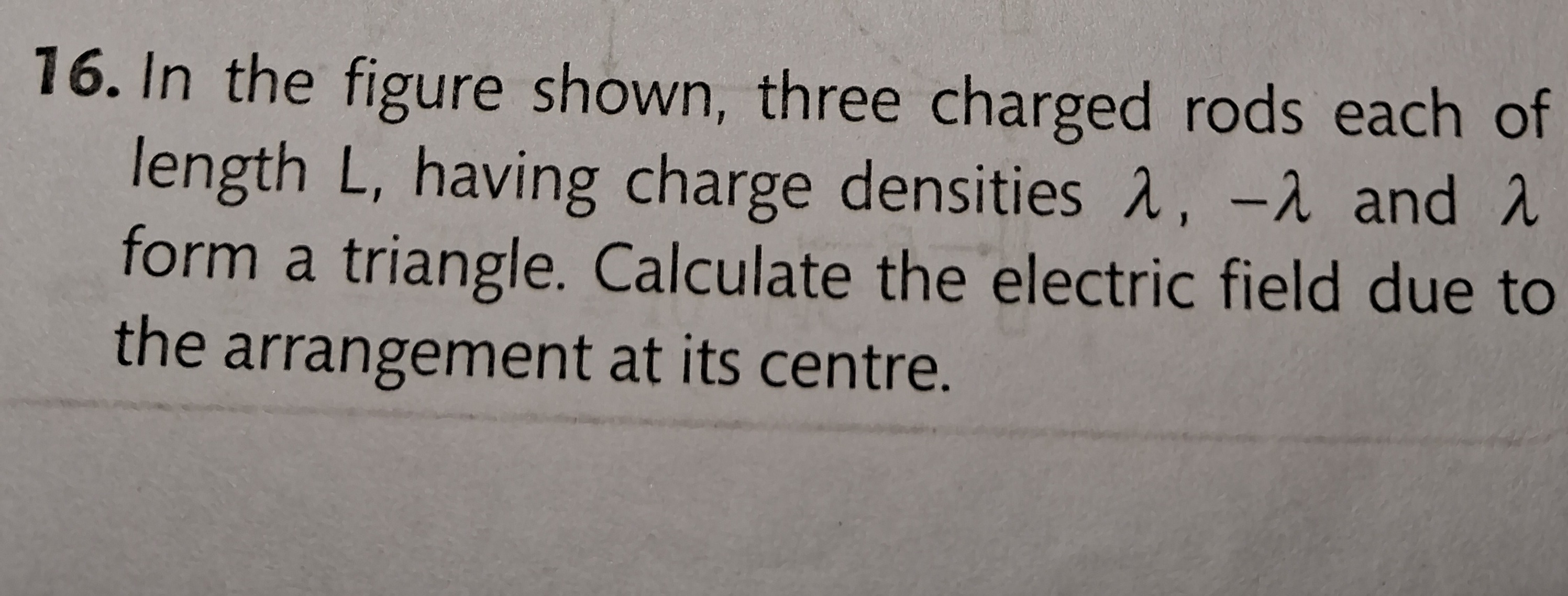Question
Question: In the figure shown, three charged rods each of length L, having charge densities $\lambda$, $-\lamb...
In the figure shown, three charged rods each of length L, having charge densities λ, −λ and λ form a triangle. Calculate the electric field due to the arrangement at its centre.

The magnitude of the electric field at the center is L6kλ.
Solution
The problem asks for the electric field at the center of a triangle formed by three charged rods of length L with linear charge densities λ, −λ, and λ. We assume the triangle is equilateral, as is standard for such problems, and the center refers to the centroid of the triangle.
1. Electric Field due to a Charged Rod: The electric field at a point on the perpendicular bisector of a uniformly charged rod of length L and linear charge density ρ at a distance d from the midpoint of the rod is given by: E=dk∣ρ∣sin(2θ) where θ is the angle subtended by the rod at the point.
2. Geometry of an Equilateral Triangle: For an equilateral triangle of side length L, the distance from the center (centroid) to the midpoint of each side is d=r=23L. The angle subtended by each side at the center is θ=120∘. Therefore, sin(θ/2)=sin(120∘/2)=sin(60∘)=23.
3. Magnitude of Electric Field from Each Rod: For each rod, the magnitude of the electric field at the center is: E0=(L/23)k∣λ∣⋅23=Lkλ⋅23⋅23=L3kλ. This magnitude is the same for all three rods, regardless of the sign of the charge density.
4. Vector Sum of Electric Fields: Let the center of the triangle be the origin (0,0). Let the vectors pointing from the center to the midpoints of the three sides be u1,u2,u3. These vectors have equal magnitude r and are separated by 120∘. Let u^1,u^2,u^3 be the unit vectors in these directions.
The electric field due to a rod is perpendicular to the rod and directed away from it if the charge is positive, and towards it if the charge is negative. The vector from the center to the midpoint of a side is perpendicular to that side.
We need to consider the vector sum of the electric fields. Let's assign the charge densities to the rods. The sum of the unit vectors from the center to the midpoints of the sides of an equilateral triangle is zero: u^1+u^2+u^3=0.
Consider the case where the charge densities are λ,−λ,λ for rods corresponding to directions u^1,u^2,u^3 respectively. The electric field vectors are E1=E0u^1, E2=−E0u^2, E3=E0u^3. The total electric field is Etotal=E1+E2+E3=E0(u^1−u^2+u^3).
Using the property u^1+u^2+u^3=0, we can express the sum in terms of two vectors. For example, u^1=−u^2−u^3. Etotal=E0((−u^2−u^3)−u^2+u^3)=E0(−2u^2). The magnitude is ∣Etotal∣=2E0.
Alternatively, let's use a coordinate system. Let u^1=(0,1). Then u^2=(−23,−21) and u^3=(23,−21). Etotal=E0[(0,1)−(−23,−21)+(23,−21)]=E0[(23+23)i^+(1+21−21)j^]=E0[3i^+1j^]. The magnitude is ∣Etotal∣=E0(3)2+12=E03+1=2E0.
5. Total Magnitude: Substituting E0=L3kλ: ∣Etotal∣=2(L3kλ)=L6kλ.
It can be shown that regardless of how the charge densities λ, −λ, and λ are assigned to the three rods, the magnitude of the resultant electric field at the center will always be 2E0. For instance, if the charges are λ,λ,−λ, the total field is E0(u^1+u^2−u^3)=E0(−u^3−u^3)=−2E0u^3, with magnitude 2E0.
Thus, the magnitude of the electric field at the center is L6kλ.
